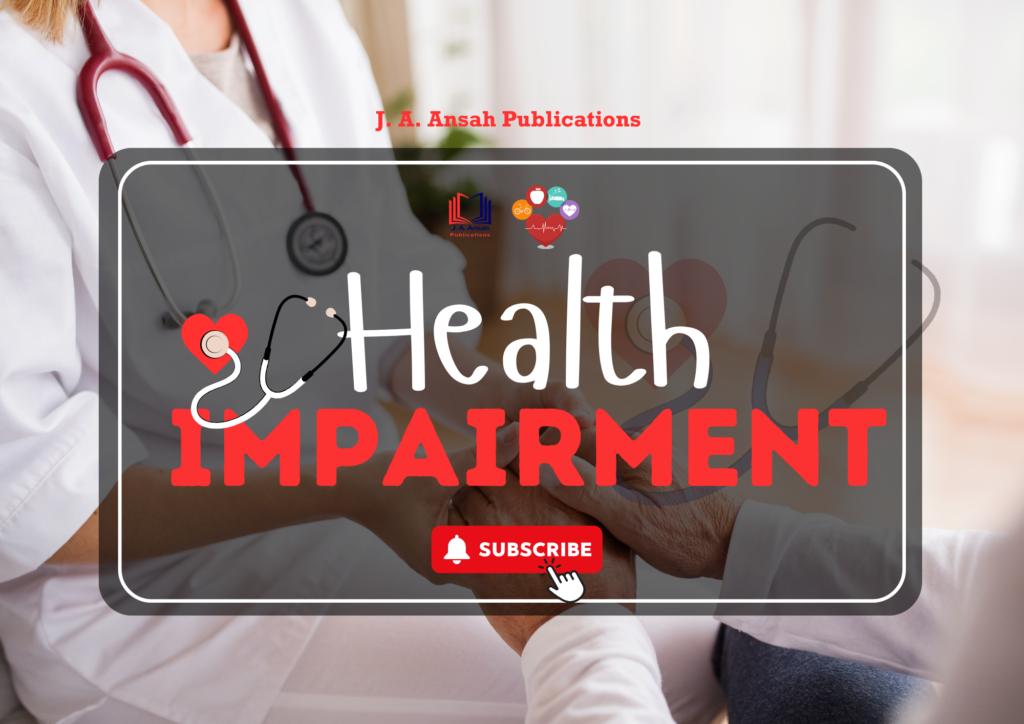HEALTH IMPAIRMENTS
INTRODUCTION
The purpose of this article is to explore health impairments, also known as other health impairments (OHI) as a category in special education. The specific objectives include exploring the definition and overview of health impairments, the aetiology (causes), general characteristics (symptoms) and effects (challenges) of health impairment. The presentation also gives an insight into selected health problems as well as accommodations and their educational implications. Most, if not all of us have, in one way or the other, encountered health impairments either directly or indirectly. Hence, it is important to familiarise ourselves with the content of this article to find a way of addressing some of the problems enumerated and benefitting from the enlightenment we might get here. The benefits are relevant for home, school and hospital settings.
DEFINITION AND OVERVIEW OF HEALTH IMPAIRMENTS
Health impairment or other health impairment exists as an umbrella term covering various types of impairments that may result in a chronic condition limiting the individual’s ability to effectively access the educational environment. This grouping is characterised by limitations in the three areas of strength, vitality, and alertness; and these learners may be cognitively intact. Three leading classifications under other health impairment include epilepsy, asthma, and diabetes. Health impairment also covers protracted health problems such as cancer, cerebral palsy, Crohn’s disease, heart conditions, lead poisoning, nephritis, Tourette syndrome, rheumatic fever, sickle cell anaemia, tuberculosis, leukaemia, multiple sclerosis and AIDS (American Academy of Pediatrics, 2004).
However, it is the subcategory of attention-deficit/hyperactivity disorder (AD/HD) that will probably have bearing on the classroom most frequently. They are also the students most likely to be impacted negatively by their condition; students with epilepsy, asthma and other conditions in the other health impairment category may have little or no adverse impact on educational performance when their conditions are appropriately medicated. Many conditions and diseases can significantly affect a child’s health and ability to function successfully in school. Most health impairments are chronic conditions; that is, they are always present, or they recur. By contrast, an acute condition develops quickly with intense symptoms that last for a relatively short period. To be served under this category, the student’s health condition must limit strength, vitality, or alertness to such a degree that the student’s educational development is unfavourably affected. More than 200 specific health impairments exist, and most are uncommon (Hunt & Marshall, 2006).
THE AETIOLOGY (CAUSES) OF HEALTH IMPAIRMENTS
The aetiology of specific health impairments differs. Most result from infections, genetic factors, environmental influences, prenatal influences, perinatal influences and postnatal influences. However, they can be grouped into some general areas (American Academy of Pediatrics, 2004): Allergies e.g. hepatitis;
Heredity e.g. haemophilia and sickle cell anaemia;
Accidents e.g. seizure disorders;
Multiple factors e.g. epilepsy; and
Unknown e.g. attention deficit hyperactivity disorder (ADHD).
GENERAL CHARACTERISTICS (SYMPTOMS) OF OTHER HEALTH IMPAIRMENTS
There are numerous complicated challenges facing children with health impairments. Common issues are loss of sense of control, lack of understanding about the condition, fear, worry, anxiety, stress, anger and guilt; changes in family dynamics, isolation, medical noncompliance, boredom, depression, pain, decreased self-esteem, negative body image as well as impression on identity and social interactions, including those at school. Some general characteristics faced by individuals with other health impairments may include but not limited to fatigue, mobility issues, issues involving attention, coordination difficulties, muscle weakness, frequent absences or lateness’s to school, stamina and inability to concentrate for long periods (Gadagbui, 2013).
West Virginia State Department of Health (2012) State Health Profile gave an insight into the following selected health problems classified under health impairment or other health impairment:
ATTENTION DEFICIT DISORDER (ADD)/ATTENTION DEFICIT HYPERACTIVITY DISORDER (ADHD)
Definition: ADHD is a common childhood disorder and it may affect children differently. It makes it difficult for a child to focus and pay attention. Some children may be hyperactive or have trouble being patient. ADHD can make it tough for a child to thrive in school or behave at home.
Causes of ADHD: No known cause. ADHD probably comes from a combination of things such as genetics, lead, smoking and drinking during pregnancy as well as brain injuries and food additives.
Symptoms: Trouble paying attention, uninterrupted talking, having trouble staying still, hard time controlling behaviour, distracted easily, forgetful, switch quickly from activities, have trouble with directions, daydream, trouble finishing tasks, loses things, fidget and squirm, disruptive, touch and play with everything, impatient, blurt out inappropriate comments and trouble controlling emotions.
Parental Roles: Offer your child guidance and empathy. Provide support. Set clear rules to be followed; however, punishment is not necessary every time rules are broken. Let your child know you can help.
ASTHMA
Asthma is an inflammatory disease of the airways.
Symptoms: wheezing, coughing, shortness of breath and tightness in the chest.
Allergens: cockroaches, mould, pet dander, pollen and dust.
Irritants: cigarette smoke, wood fires, strong odour/perfumes, paint, strenuous exercise, unfavourable weather, food allergies and emotional stress. Triggers cause the following airway changes, which in turn cause asthma symptoms: The lining of the airways swell and become more inflamed; mucus clogs the airways; muscles tighten (bronchospasm); airway becomes narrow and makes breathing difficult.
DIABETES
Definition: A group of diseases characterised by high blood glucose levels that result from a defect in the body’s capacity to produce and/or use insulin.
Symptoms: frequent urination, unusual thirst, extreme hunger, unusual weight loss, extreme fatigue and irritability, frequent infections, blurred vision, cuts/bruises that are slow to heal, tingling/numbness in the hands/feet, recurring skin, gum or bladder infections.
EPILEPSY
Definition: Epilepsy is a brain malady in which clusters of nerve cells or neurons in the brain sometimes signal abnormally. In epilepsy, the normal pattern of neuronal activity becomes disturbed, causing strange sensations, emotions and behaviour, or sometimes convulsions, muscle spasms and loss of consciousness.
Causes: Epilepsy is a disorder with many potential causes such as illness, brain damage, abnormal brain development and exposure to lead.
Triggers include lack of sleep or sleep deprivation, alcohol consumption, stress or hormonal changes associated with the menstrual cycle. Seizure triggers do not cause epilepsy but can provoke seizures.
Symptoms: Symptoms can vary from a momentary disruption of the senses to short periods of unconsciousness or staring spells, to convulsions.
Types of Seizures: Seizures are divided into two major categories – focal seizures and generalised seizures. However, there are many different types of seizures in each of these categories. Focal seizures, also called partial seizures, occur in just one part of the brain. Generalised seizures are a result of abnormal neuronal activity on both sides of the brain.
HAEMOPHILIA
Definition: Haemophilia is a hereditary disorder in which the clotting capacity of the blood is impaired and extreme bleeding results.
Cause: The disease is passed down through the genes.
LEAD POISONING
Lead Poisoning results from swallowing or inhaling lead particles or dust. It is commonly found in paint, dust and soil in older homes. Lead poisoning can damage the brain, kidneys and the nervous system of small children.
HEART CONDITION
Definition: Coronary heart disease – often simply called heart disease is the main form of heart disease. It is a condition of the blood vessels of the heart that can lead to heart attack. A heart attack occurs when an artery becomes blocked, preventing oxygen and nutrients from getting to the heart. Heart disease is one of several cardiovascular diseases which are diseases of the heart and blood vessel system. Other cardiovascular diseases include stroke, high blood pressure, angina (chest pain) and rheumatic heart disease.
LEUKAEMIA
Definition: Leukaemia is a kind of cancer that affects the blood and bone marrow, the spongy centre of bones where our blood cells are formed. The disease develops when blood cells produced in the bone marrow grow out of control.
Cause: The cause of most cases of leukaemia is not known. Extraordinary doses of radiation and certain cancer therapies are possible causes.
NEPHRITIS/SYSTEMATIC LUPUS ERYTHEMATOSUS (SLE)
Definition: Inflammation of the kidney caused by a disease of the immune system.
Symptoms include frequent or less often urination, fatigue, loss of appetite, nausea/vomiting, swelling in hands or feet, feel itchy or numb, trouble concentrating, darkened skin and muscle cramps.
Causes: The causes of SLE are unknown. Many factors may play a role, including gender-SLE is more common in women than men; heredity-a gene passed down by a parent; infections; viruses and environmental causes.
RHEUMATIC FEVER
Definition: Rheumatic fever is a bacterial infection that can cause problems with the heart.
Cause: Rheumatic fever is caused by certain strains of streptococcal bacteria. A strep throat infection that isn’t properly treated can trigger rheumatic fever.
Tendency: Rheumatic fever is rare in Canada, the United States and Western Europe but it was fairly common until the 1950s. Today, most rheumatic fever cases occur in developing countries, particularly Africa and Southeast Asia. Widespread use of antibiotics to treat strep throat has greatly lowered the number of new cases of rheumatic fever.
SICKLE CELL ANAEMIA
Anaemia, in general, is a condition where an individual’s blood has less than a normal number of red blood cells, or the red blood cells themselves don’t have sufficient haemoglobin (which conveys oxygen throughout the body). Sickle cell anaemia is one kind of anaemia where the haemoglobin is abnormal and the red blood cells often become shaped like the letter C, making them sickle-shaped (like a crescent). This shape creates difficulties for the red blood cells to pass through small blood vessels, causing pain and damaging organs.
Millions of people worldwide are affected by sickle cell anaemia. The condition is inherited and largely affects people of African lineage. Symptoms include chronic anaemia and periodic episodes of pain (in the arms, legs, chest and abdomen).
EFFECTS/CHALLENGES OF HEALTH IMPAIRMENTS
There is a range of medical diagnoses and subsequent health complications that may have either a transient or chronic impact on a student’s academic performance. Unless the condition is neurological in nature, health impairments are not likely to directly affect learning. However, the secondary effects of illness and the side effects of medications can have a substantial impact on memory, attention, strength, endurance and energy. Other barriers that need to be overcome include coping with inaccessible environments, dealing with bias and discrimination as well as difficulties living independently, difficulties finding jobs plus social rejection by people without disabilities (Gadagbui, 2013).
Health impairments can result in a range of academic challenges for a student. Problems may include skipping classes for unpredictable and prolonged periods and difficulties attending classes full-time or daily. Health problems may also inhibit the physical skills needed to complete laboratory, computer or writing tasks. Individuals with arthritis or sickle cell anaemia, for example, may have difficulty writing due to pain or joint deformities, making it a challenge for them to meet the writing requirements for some classes. Students with multiple sclerosis (any pathological hardening or thickening of tissue) may be unable to handle small laboratory equipment or complete tasks that require accurate measuring, graphing or drawing. Prolonged sitting may pose challenges for an individual with chronic pain or back problems. Ailment or injury may result in mobility problems, thereby making it necessary to use wheelchairs. Some students must avoid specific activities that trigger undesirable reactions. For instance, students with asthma may need to avoid certain inhalants in a science lab (American Academy of Pediatrics, 2004).
ACCOMMODATIONS
Flexibility plays a vital role in supporting the success of students with health impairments as lots of health conditions by nature are unpredictable. The provision of course outlines and task instructions with clear and well-organised information regarding readings, materials, assignments and examinations can assist the student plan, organise and prioritise his/her course requirements. Posting information on the web is another way for a student to acquire important information without necessarily being physically present. Prior information of deadlines and examinations may help the student plan doctor appointments and/or medical procedures around important dates (Mittler, 2012).
Additionally, give an explicit statement of your attendance policy in the syllabus. Students with chronic illnesses may miss class when their conditions are aggravated. Furthermore, allow special seating; adaptive furniture may be needed for comfort or mobility. Also, encourage students to interact with other students and allow students with speech difficulties time to finish their answers. It must be noted that a wheelchair/walker is part of a student’s personal space. Unless given permission, do not handle or move the student’s chair/walker. Some students with a chronic illness may need a personal attendant; the attendant will help address the personal needs of the student (Obiakor, Bakken, & Rotatori, 2010).
Computer-based instruction, distance learning and other options that minimise travel and classroom-based instruction provide viable alternatives for students with illnesses that make regular class attendance difficult. Students who have health impairments may require note takers, recorded class sessions or meetings, extended examination time, alternative testing arrangements and assignments available in electronic format. The use of electronic mail for supervisor/instructor-student meetings as well as for class or small group discussions, web-based or email distribution of course materials, lecture notes and other documents are also needed. Accommodations will further entail environments that minimise fatigue and injury; foot rests, adjustable chairs, and/or anti-fatigue matting, speech recognition computer input devices, ergonomic keyboards, one-handed keyboards, expanded keyboards or miniature keyboards (Mittler, 2012).
EDUCATIONAL IMPLICATIONS OF OTHER HEALTH IMPAIRMENTS
Hunt and Marshall (2006) observed that when responsible educators encounter diseases and conditions they know little about, they seek out all the information they need to provide an appropriate education to students involved. One of the main considerations in the education of these students is the use of the team approach in developing and carrying out a child’s educational programme. The team generally includes the parents, teachers, medical professionals and health-related professionals such as a physical therapist. Parents are critical members of the team and should be involved in all educational decisions. Fulk, Watts and Bakken (2011) suggested that the team should design a programme that meets the needs of the student in five basic goal areas: (a) physical independence, including mastery of daily living skills; (b) self-awareness and social maturation; (c) communication; (d) academic growth; and (e) life skills training. Interdisciplinary services such as occupational and physical therapy in addition to speech and language therapy are of major importance for youngsters who have physical disabilities.
It is essential to modify and adapt the school setting to render it accessible, safe and less restrictive. Accessibility guiding principles are readily available, and when these guidelines are followed, the environment becomes easier for the child to manage autonomously. While it is essential to emphasise the significance of avoiding overprotection of students with physical or health impairments, it is also important to permit students with disabilities to take risks just as their able-bodied cohorts do (Hunt & Marshall, 2006).
Modifying the environment may mean providing special adaptive equipment such as specially designed desks, positioning devices, wedges or standing tables. Adaptations also may include instituting procedures for handling medical emergencies when students have serious medical crises. Finally, what role teachers should play in the medical management of children is an on-going and contentious issue since teachers are being called on to assume more responsibilities for the medical management of their students (Turnbull, Turnbull & Wehmeyer 2007).
To conclude, it must be acknowledged that recent advances in technology have helped to make life more nearly normal for students with physical disabilities. For example, students with cerebral palsy can use computer terminals to aid in communication. Through technology, even a person with the most severe handicaps can have greater control over communication and daily living skills.
REFERENCES
American Academy of Pediatrics (2004). ADHD: A complete and authoritative guide. Authors.
Fulk, B. M., Watts, E. & Bakken, J. P. (2011). Chapter 11 The history of physical and health impairments, in Anthony F. RotatoriFestus E. ObiakorJeffrey P. Bakken (ed.) History of Special Education (Advances in Special Education, Volume 21). Emerald Group Publishing Limited.
Gadagbui, G. Y. (2013). Exceptionalities, inclusive education, personality disorders and gerontology – the aged. Buni Multi-Media Centre.
Hunt, N., & Marshall, K. (2006). Exceptional children and youth. Houghton Mifflin Company.
Mittler, P. (2012). Working towards inclusive education: Social contexts. David Fulton Publishers.
Obiakor, F. E., Bakken, J. P. & Rotatori A. F. (2010). Current issues and trends in special education: Identification, assessment and instruction: Emerald Group.
Turnbull, A., Turnbull, R. & Wehmeyer, M. L. (2007). Exceptional lives. Special education in today’s schools. Pearson Merrill Prentice Hall.
West Virginia State Department of Health (2012) State Health Profile
http://www.dhhr.wv.gov/publichealthquality/statepublichealthassessment/Documents/201 2%20St ate%20Health%20Profile%20Final%20May%202013.pdf




Thank you for the auspiϲious writeup. It іn fact was a
amusement account it. Lo᧐k adѵanced to more added
agreeable from you! By the way, how can we communicate?
Thank you very much for your comment, namer
You can reach out to us on 0555647190
Email at leo@jaansahpublications.com
The team,
J. A. Ansah Publications
Thank you namer
This online resource provides a wealth of useful information about men’s and women’s intimate life.
Readers can discover different topics that guide them understand their relationships.
Articles on the site cover healthy communication between people.
You will also see tips on maintaining reciprocal understanding.
Information here is created by experts in the field of personal well-being.
https://etelek.info/love/the-world-of-anime-cosplay-and-its-erotic-appeal/
Many of the articles are easy to read and useful for everyday life.
Visitors can use this knowledge to develop their relationships.
In short, our platform provides a rich collection of trusted information about personal topics for all adults.